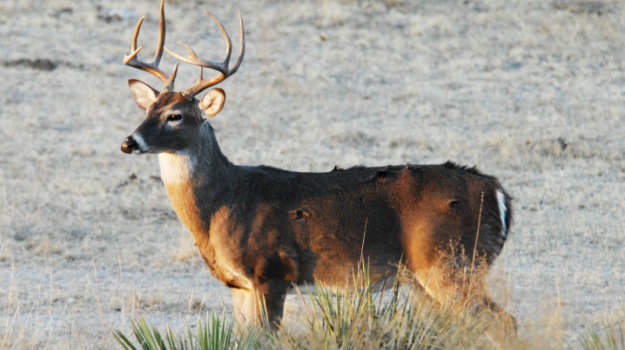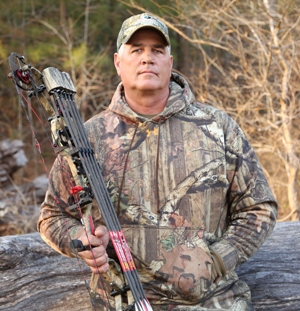
Editor’s Note: Kevin Burleson has owned Heart of Texas Bowhunting for 13 years, 16-miles west of Brady, Texas. Geographically it’s right dead center in the middle of Texas. He's been a Mossy Oak Pro Staffer for 10 years and is one of the Mossy Oak Deer Thugs on the TV show on the Pursuit Channel. A bowhunter since he was 19-years old, he's also a member of the PSE Pro Staff. “I've been wearing Mossy Oak camouflage as along as Mossy Oak has been making Mossy Oak camouflage,” Burleson says. Can you imagine seeing 30 to 40 bucks each day that you hunt? The deer-management system that Kevin Burleson uses may not produce this type of results on other properties in the U.S. However, this management system works for Burleson in Texas.
One of the reasons that more mature bucks show up on our 8,000 acres at Heart of Texas Bowhunting is that we create a sanctuary for bucks. I’ve been asked many times, “How in the world can you say that the 8,000 acres that you hunt is a sanctuary when annually you’re taking 300 to 400 deer off your ranch?” To understand how we can call our ranch a buck sanctuary, the first thing you need to understand is what causes deer to move into a sanctuary. I’m totally convinced that increased vehicle movement on any lands during deer season causes the older-age-class bucks to be the first deer to leave that property. We have rules in place to keep driving any type vehicle to a minimum on our property. We have certain points that a hunter can’t drive his vehicle past. The second reason that older-age-class bucks move off a property is increased hunter pressure. For this reason, our hunters have to stay in their ground blinds or tree stands until at least 10:30 am, but preferably until 11:00 am. Then we ask them to walk straight back to their vehicles. We know that by 10:30-11:00 am, most of our bucks are usually going to be bedded-down somewhere, so there’s not much chance for a hunter to spook them if he or she follows our rules.
 We don’t allow our hunters to go to their blinds any later than at a certain time. Once again, this way we try and reduce the chances of a hunter spooking a deer or being seen or smelled by a deer. These rules are put in place to help the hunter not spook the deer he’s trying to take. We’ve done all in our power to reduce hunter pressure. Although each one of our 500- to 600-acre hunting areas are side by side, no hunter crosses another hunter’s area going to or driving to his stand. Each hunter can drive to his area but he only crosses about one-fifth of his area before he has to park his vehicle and walk to his blind. Using this strategy, the only human scent that the hunter can leave is from his vehicle to his stand and back. The only person other than the hunter who goes into these hunting sites is me. The only reason I go into the hunting sites is to pick up a dead deer and fill-up feeders. All the property owners around our ranch have hunters driving around on their properties looking for deer and walking around scouting for deer. So, the most hunting or vehicle pressure the deer in our region will experience is coming from outside our lands, which moves older-age-class bucks onto our property.
We don’t allow our hunters to go to their blinds any later than at a certain time. Once again, this way we try and reduce the chances of a hunter spooking a deer or being seen or smelled by a deer. These rules are put in place to help the hunter not spook the deer he’s trying to take. We’ve done all in our power to reduce hunter pressure. Although each one of our 500- to 600-acre hunting areas are side by side, no hunter crosses another hunter’s area going to or driving to his stand. Each hunter can drive to his area but he only crosses about one-fifth of his area before he has to park his vehicle and walk to his blind. Using this strategy, the only human scent that the hunter can leave is from his vehicle to his stand and back. The only person other than the hunter who goes into these hunting sites is me. The only reason I go into the hunting sites is to pick up a dead deer and fill-up feeders. All the property owners around our ranch have hunters driving around on their properties looking for deer and walking around scouting for deer. So, the most hunting or vehicle pressure the deer in our region will experience is coming from outside our lands, which moves older-age-class bucks onto our property.
Antler restrictions also create sanctuaries for young and older bucks. Our 8,000 acres has become the only sanctuary, out of thousands and thousands of acres, where hunting pressure is at a minimum. Our harvest regulations also favor the bucks. If the buck is 9 points or less, the buck has to score 120 inches or less for the hunter to be able to take him. If the buck is a 10-pointer or more, the buck has to score a minimum of 125 inches for the hunter to be able to take him. By having these antler restrictions, a good hunter should see 5 to 7 shooter bucks on a 3-day hunt. We’re trying to harvest bucks that are 3-4-years old or older. So if a deer is a 1-1/2-year-old buck, a 2-1/2-year-old buck and sometimes a 3-1/2-year-old buck, he’s home-free for usually 1 to 3 years before he becomes a target. However, on any other property around us, that buck may get shot. By studying our age structure and antler development, we’ve learned that generally a buck that has 120 inches of antler is most often a 3-year-old-or-older buck.
Harsh Penalties:
To discourage our hunters from shooting marginal bucks, we impose financial penalties on bucks taken that are less than 120 inches. By having a financial penalty, if a hunter sees a buck that may score 120 inches, but he’s not sure whether he should take the shot or not, he doesn’t want the penalty. So, he’ll let that buck walk. He’ll wait until he sees another buck that will probably score 125 or more. The penalties prevent the hunter from taking those deer that may or may not have 120 inches of antler. Before the hunters go out to hunt, we show them videos of different deer. We ask them to guess the score and then tell them what that deer actually scores. We also have different sizes of racks for the hunters to look at and guess their scores. By the time we finish with our orientation, the hunter is well-educated on field-judging a buck’s rack before he shoots. On bucks 10 points or better, most of our hunters will harvest a buck that scores 135 or more rather than taking a chance of shooting an undersized buck and having to pay a penalty. Even though we have our minimums of 120 to 130, most of the bucks harvested will be 5-inches more than the minimum.
To see what Heart of Texas Bowhunting’s management is producing, click here. You can check out the Heart of Texas Bowhunting Facebook page at www.facebook.com/heartoftexasbowhunting.
Day 2: Heart Of Texas Bowhunting Hunters Harvest Deer Scoring 150-160
Tomorrow: Kevin Burleson’s Insurance Program for Taking the Right Sizes of Bucks



























